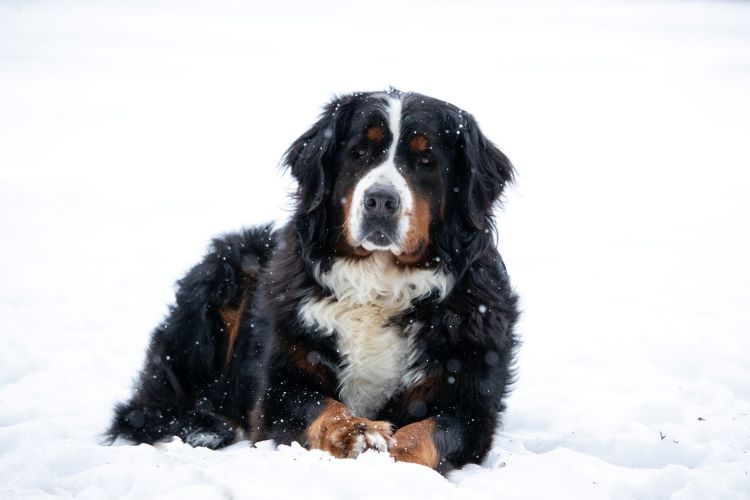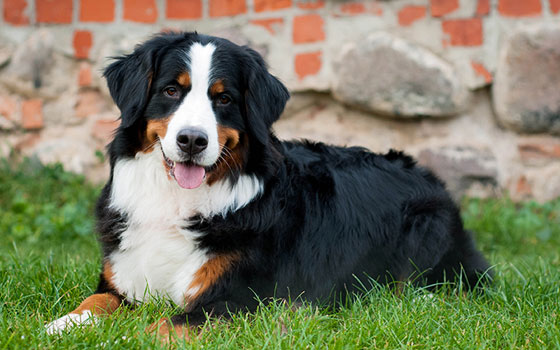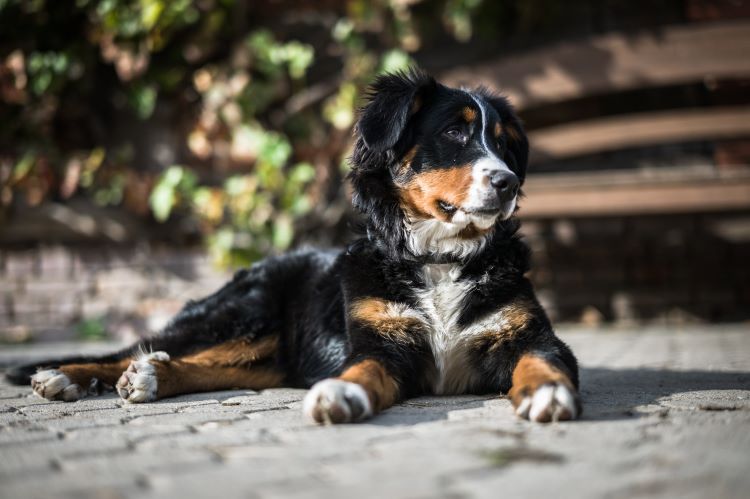Ready to help treat your pet to a healthy life?
Bernese Mountain Dog Facts, History & Breed Details
By : Trupanion Staff | Updated Feb 1, 2024

You may recognize the Bernese Mountain Dog as a big, tri-colored dog breed, but just how friendly are they, how much upkeep do they require, and do Bernese Mountain Dogs make good family pets? All of these are important questions to ask before deciding whether or not the breed is a good fit for your family.
The truth is that the Bernese Mountain Dog can be a great adventure buddy, family pet, or intelligent and capable working dog. These impressive canines do require a lot of care, however, and no prospective pet owner should go in blindly. Whether you're considering adopting a Bernese Mountain Dog or are just interested in learning more about the breed, this comprehensive guide is here to help. Read on for fun facts, breed history, health and care information, and more!
Whether you have a Bernese Mountain Dog or other canine breed, be sure to protect them with dog insurance.
Interesting facts about Bernese Mountain Dogs
- They can be big dogs! The Bernese Mountain Dog weighs between 70 and 116 pounds at maturity and typically stands between 23 and 28 inches tall.
- Referred to as a mountain dog in English-speaking countries, in Europe the Bernese and their cousin breeds are called Sennenhunds. This comes from the German Senne (“alpine field or pasture”) and Hund (“dog/hound”). Bernese Mountain Dogs are so named because they hail from the Swiss region of Bern.
- Since the full breed name is quite a mouthful, many people refer to this dog simply as the “Berner” or just Bernese.
- The Bernese is one of four native breeds to the Swiss mountains. All have the same tri-color coat but are different sizes. The Greater Swiss Mountain Dog is the largest, followed by the Berner. The Appenzeller and the Entlebucher are the smaller of the group. The Bernese Mountain Dog is the only one with a long coat.
- Bernese Mountain Dogs tend to keep their puppy brains longer than other breeds. Their jovial and playful antics stick around well into their adolescent phase.
- NFL quarterback Ben Roethlisberger brought home a Bernese Mountain Dog named Hercules from Switzerland after visiting to connect with his Swiss roots.
- The breed was at risk of dying out in the late 1800s, due to lower demand for working dogs on farms and the increased popularity of the Saint Bernard breed. Thanks to the preservation efforts of Swiss mountain dog breed fanciers, the Bernese was able to make a comeback and has become quite popular.
History of the Bernese Mountain Dog
Developed in the Swiss Alps, the Bernese Mountain Dog can trace its roots to the Molossian mastiff-type dogs that followed the Roman legions throughout the continent during the 1st century. These dogs interbred with the farm dogs in the mountainous area and became known as Sennenhunds, or “alpine field dogs.” Over the next 2,000 years, they were further refined into four distinct mountain dog breeds: The Greater Swiss, Bernese, Appenzeller, and Entlebucher.
The Bernese Mountain Dog proved integral to the agrarian life in the mountains due to their versatility. The breed would act as livestock herders, guardians, companions, and thanks to their strong back legs and sturdy frame, were excellent carting dogs. As the Industrial Revolution spread throughout Europe, the need for working farm dogs diminished. In the late 1800s, Bernese Mountain Dogs were at risk of going extinct. At the turn of the 20th century, Swiss dog fanciers worked to save their native mountain breeds. In 1904, the Swiss dog club introduced a Swiss shepherd dog class, which included the Bernese and launched the breed’s comeback.
After World War I, the first Bernese Mountain Dogs were exported to Holland and the United States, and the American Kennel Club recognized the breed in 1937 as a member of the Working Class. While World War II interrupted Swiss imports of Berners, they continued to slowly grow in popularity. The Bernese Mountain Dog Club of American was formed in 1968 and registered just 43 dogs of the breed. Slowly but surely, they’ve climbed their way into the hearts of many dog owners. Berners ranked as the 22nd most popular dog breed in the United States in 2018.

Do Bernese Mountain Dogs make good pets?
Bernese Mountain Dogs are big, fluffy goofballs that form a close bond with their family. While they’re often shy when first meeting new people, they’ll soon open up to show their friendly, intelligent, and inquisitive nature. Their large size doesn’t hinder their desire to be physically close to their people, and they love galivanting around with glee.
Similar dog breeds
- Great Swiss Mountain Dog
- Great Pyrenees
- Entlebucher Mountain Dog
- Appenzeller Sennenhund
- Newfoundland
Bernese Mountain Dog behavior and training
Bernese Mountain Dogs are dependable and sturdy dogs that enjoy work and pleasing their owners. As a versatile breed, they take to all kinds of training and different dog sports. Their intelligence makes them fast learners, but the breed can be on the shy side with new people, making socialization as a puppy and positive reinforcement training methods a must. Their large size means training should start early to help them learn physical boundaries and polite manners, so they don’t accidentally overwhelm others.
If you're considering adopting a Bernese Mountain Dog, they will need regular exercise every day. These are strong, muscular dogs that risk becoming overweight and experiencing health problems with sufficient exercise, and they may also display behavioral issues as a result. Scroll down to learn more about the breed's exercise needs.
Mental enrichment
Bernese Mountain Dogs are intelligent but also know how to sit back and enjoy life. Work their brains by providing them with food puzzles and interactive toys. This breed does well with all kinds of dog sports, and signing up for a nose work or tracking class not only exercises their brain but also burns off excess physical energy. By providing mental enrichment, you’ll keep your Berner from getting bored (which often leads to problem behaviors like chewing or digging). Puppies benefit quite a lot from mental exercise, and you’ll prevent lots of normal puppy “problem” behaviors by giving them an appropriate outlet for all that energy.
Bernese Mountain Dog socialization
Berners can be more reserved during new experiences, but will be friendly, outgoing dogs with an owner committed to early socialization and training. Proper proactive exposure to new sights, sounds, people, dogs, and other animals as a young puppy is essential for their socialization skills.
This breed can be an excellent dog for families with children, as long as they’ve been socialized since puppyhood (and children are taught polite interactions with dogs). A Berner’s size makes it easier for them to tolerate the physical contact from kids, and they tend to be affectionate with their family members. Young children and dogs should always be supervised, and it’s helpful for a dog to have their own “safe space” where they can go when they need some quiet time.
Bernese Mountain Dogs can do quite well with other pets in the home — as with all dog breeds, it’s all about proper socialization as a puppy and consistent management. Provide a Berner puppy with positive introductions to animals of all kinds to set them up for a lifetime of success. Sometimes their large size might be intimidating to other dogs, so early socialization and training will go a long way in helping them learn how to play and interact.

Caring for a Bernese Mountain Dog
Taking good care of a Bernese Mountain Dog requires a lot of dedication and love, though lovers of the breed find it all highly rewarding. With their needs met, these dogs become devoted and close members of the family.
Exercise and health needs
Bernese Mountain Dogs need at least 30 minutes of daily exercise. Not only will this help prevent unwanted behaviors, but it will also help to keep your Berner at a healthy weight. Regular walks and backyard play will burn off excess energy and build the bond between you and your Bernese. This breed can make an excellent jogging or hiking partner once they are fully grown.
Their thick black coat can make them more susceptible to heatstroke. Use caution and limit exercise in warmer temperatures or when it’s humid outside, and provide lots of breaks and water. Berners should always be monitored for heatstroke symptoms: rapid panting, drooling, bright red tongue or gums, and trouble breathing.
Speak with your veterinarian about appropriate exercise for a Bernese Mountain Dog puppy. Until they’re fully grown (bone growth plates typically all close around 18 months of age), avoid jogging or running beyond what they would do on their own. This limits the risk of damage to the growing bone and cartilage, which can cause pain and future joint issues.
Bernese Mountain Dogs are at greater risk for hip dysplasia. Though many factors play into a particular dog’s risk level (including genetics, nutrition, and exercise), it’s important to discuss the prevalence of hip dysplasia in the line, with the breeder(s) you’re considering. You should also talk to your vet about having your puppy screened for hip dysplasia. This is done with both a physical exam and radiographs (X-rays). While the development of hip dysplasia can’t necessarily be prevented, the pain, mobility issues, and other negative symptoms of the condition can be minimized with proper diagnosis and management.
Ideal activities for the Bernese Mountain Dog
Bernese Mountain Dogs do well in many different activities:
- Draft work / Cart Pulling
- Therapy Work
- Rally Obedience
- Agility
- Nose work / Tracking
- Herding
- Skijoring
Grooming and care
Berners have a luxurious double coat. The topcoat is silky soft and grows to a moderately long length (about two to three inches). Their undercoat is wooly and provides excellent insulation in cold weather. Be aware, the thickness of their coat, and black color, may make Bernese Mountain Dogs more susceptible to heatstroke in hot or more humid climates.
The Bernese Mountain Dog coloring is seen in all 4 of the Swiss mountain breeds, but Berners are the only ones with a long coat. The black body, white on the chest and face, and rust markings on the face and feet are referred to as Tri-color. The white blaze on this breed’s chest is called a “Swiss cross.” Some Berners even sport a “Swiss kiss,” a white spot on the back of their necks.
The Bernese Mountain Dog needs regular brushing to keep shedding manageable and prevent tangles in their coat. This breed has a shiny coat thanks to natural oils from the skin. Brushing helps to evenly distribute these oils and keep their skin and coat healthy. Bathing only needs to be done when a Berner gets especially dirty or smelly, as bathing too frequently can strip the coat of these natural oils.
Some owners of this breed have their dog professionally groomed to neaten up their fluffy coats, asking for a “Beach Clip” or partial trim that relies on scissoring the skirt and feathers, rather than clipping the double coat. It’s not advised to clip a double-coat, as it can result in uneven grow out, damage to the hair follicles, and increases the chance of sunburn, skin cancer, and overheating. A double coat, when well-maintained, actually helps keep a dog cool, facilitating airflow across the skin. If you decide to have a double-coated breed clipped, whether per your veterinarian’s advice in dealing with skin issues or personal preference, it’s important to choose a groomer that knows how to avoid damaging the undercoat. Having your Bernese Mountain Dogs coat clipped short will not reduce the amount of shedding. Regular brushing (and investing in a quality vacuum) is your best bet in the fight against fur.
Introduce your Bernese puppy to brushing at a young age and pair it with positive rewards. This will help them learn that being brushed and groomed is a fun experience and make lifelong grooming a breeze.
Best Brush for a Bernese Mountain Dog:
Pin comb, Slicker brush

Bernese Mountain Dogs in pop culture
Thanks to their energy and intelligence, these dogs have made their way into the homes of celebrities and into the hearts of many as heroes in works of art.
Famous Owners of the Bernese Mountain Dog
- Hilary Duff (Actress)
- Sarah Michelle Gellar (Actress)
- Chelsea Handler (Comedian)
- Eliza Dushku (Actress)
- Mark Harmon (Actor)
- Courtney Cox (Actress)
- Michael D. Higgins (Politician)
- Jasmine Harman (TV Presenter)
Bernese Mountain Dogs in Books, Movies and TV
- Cujo (Bernese Mountain Dog mix) in Stephen King's Cujo
- Logan in the movie, R.I.P.D.
- Mr. Mertle's dog in the movie, The Sandlot
- Max in the movie, A Dog's Journey
- Duke in the movie, The Secret Life of Pets
- Mia in the movie, Crimson Peak
